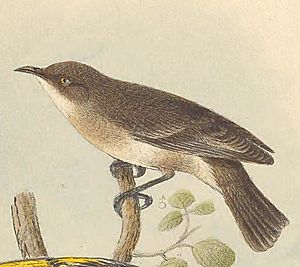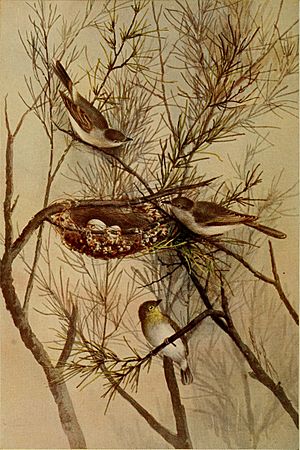Grey honeyeater facts for kids
Quick facts for kids Grey honeyeater |
|
|---|---|
 |
|
| Illustration by Henrik Grönvold | |
| Conservation status | |
| Scientific classification | |
| Genus: |
Conopophila
|
| Species: |
whitei
|
| Synonyms | |
|
Lacustroica whitei North. |
|
The grey honeyeater (Conopophila whitei) is a small bird that belongs to the honeyeater family. It is not often seen and lives in faraway parts of central Australia. This means it is an endemic bird, found only in Australia.
Contents
About the Grey Honeyeater
How Scientists Name Birds
The grey honeyeater is part of a group of birds called Conopophila. It belongs to the larger Meliphagidae family. A scientist named A. J. North first described this bird in 1910. He first called it Lacustroica whitei.
A man named F. Lawson Whitlock found this bird in 1903 near Lake Austin in Western Australia. He sent two bird samples to a museum, but he didn't hear back. In 1909, Whitlock found another grey honeyeater. He also found a nest with a breeding pair near Wiluna. He carefully watched the nest and later collected it for study. These samples helped North write the first official description of the bird.
The name whitei honors Alfred Henry Edsworth White. He was the son of another bird expert, Henry L. White. The name Conopophila comes from old Greek words. Konops means 'gnat' and philos means '-loving'. So, the name means 'gnat-loving'. People also call this bird White's honeyeater or inconspicuous honeyeater.
What the Grey Honeyeater Looks Like
The grey honeyeater is a very small bird. It is about 10.5 to 12 centimeters (4 to 4.7 inches) long. It has a plain grey color, which helps it blend in.
Its upper body is mostly cool grey. Its lower parts are lighter, turning a bit browner before it sheds its feathers. The tail and wing feathers are dark brownish-black. There is a slightly darker mark that goes from its eye to its beak. The tips of its tail feathers are white, but they turn a yellowish-brown as the bird gets older.
The beak is short for a honeyeater. It curves down a little and is grey, becoming black at the tip. Around its eye, there is a faint, light ring of feathers that are slightly yellowish-brown. The bird's eyes are brown, and its legs are steel grey.
Young grey honeyeaters have a faint yellowish ring around their eyes. This ring almost disappears as they grow up. Their throat feathers are also pale grey with a yellowish tint. The grey wing feathers of young birds have a yellow-green color.
The grey honeyeater looks a bit like other birds. These include the Western gerygone (Gerygone fusca) and the yellow-rumped thornbill (Acanthiza chrysorrhoa). It often flies with these birds in mixed species flocks. It can also be confused with the female redthroat (Pyrrholaemus brunneus).
What the Grey Honeyeater Sounds Like
The grey honeyeater has a special call. It sounds like a sharp, metallic, quick double squeak. People describe it as "chirra-wik-chirra-wik" or "cre-seek". It can sound a bit like the call of the white-bellied cuckooshrike (Coracina papuensis). It also makes a soft, high-pitched tinkling sound. Sometimes it makes a sad series of quick notes, like "troo-whee, troo-whee".
Where the Grey Honeyeater Lives

The grey honeyeater lives in the middle and western parts of Australia. You can find it especially in the Pilbara and Murchison areas of Western Australia. It also lives in southern and central Northern Territory. It is not common and usually stays in one area. However, it might move around a bit.
This bird lives in dry areas with mulga (Acacia aneura) trees. It also likes other similar acacia scrublands. The presence of mistletoe plants might be important for where these birds choose to live.
Some good places to spot the grey honeyeater are the Olive Pink Botanic Garden in Alice Springs, Northern Territory. You can also find them in Wanjarri Nature Reserve, south of Wiluna, and near Tom Price in Western Australia.
Grey Honeyeater Behaviour
Reproduction and Life Cycle
The grey honeyeater's breeding season is usually from August to November. If there is summer rain, it can last until May. The nest is a small, weak, and messy cup. It is made of thin grass stems and lined with hair and plant fluff. The birds use spider webs to hold it together. The nest hangs from thin branches in the outer leaves of a mulga shrub.
A female grey honeyeater lays 1 or 2 eggs. Each egg is about 17 by 13 millimeters (0.67 by 0.51 inches). The eggs are oval-shaped and slightly shiny white. They have reddish-brown spots. Both the male and female birds likely take turns sitting on the eggs (incubation). They also both help feed the baby birds in the nest and after they learn to fly.
What the Grey Honeyeater Eats
The grey honeyeater mainly eats insects. It busily picks lerp and other insects off the surface of leaves. It can also hover in the air to catch flying insects.
Besides insects, it also drinks nectar from flowers. It pokes its beak into the long, tube-shaped flowers of plants like Eremophila. It also eats nectar and berries from mistletoe plants.
Conservation Status
The grey honeyeater is listed as a species of least concern by the IUCN Red List. This means it is not currently in danger of disappearing globally. However, in Western Australia, it is considered an endangered bird.
The main threats to the grey honeyeater are uncontrolled fires. After a fire, mulga trees, which the birds rely on, take many years to grow back. Also, animals like cattle or goats that are not native to Australia graze in these areas. This grazing damages the bird's habitat.
See also
 In Spanish: Mielero de White para niños
In Spanish: Mielero de White para niños


